Leadership and Management Roles in Sainsbury's Operations
VerifiedAdded on 2020/10/22
|18
|5377
|314
Report
AI Summary
This report delves into the realm of leadership and management, focusing on the operational strategies of Sainsbury, a major UK supermarket chain. It begins by comparing the roles and characteristics of leaders and managers, highlighting their differing skills and responsibilities, with specific examples. The report then explores the application of leadership and managerial functions in various situational contexts, such as conflict resolution, sales reduction, and employee turnover. It further examines diverse leadership theories and models, including situational leadership. Key approaches to operation management are outlined, emphasizing their significance in achieving business objectives. Finally, the report analyzes the factors affecting operational management and decision-making processes, providing a comprehensive overview of leadership and management practices within the context of Sainsbury's operations.
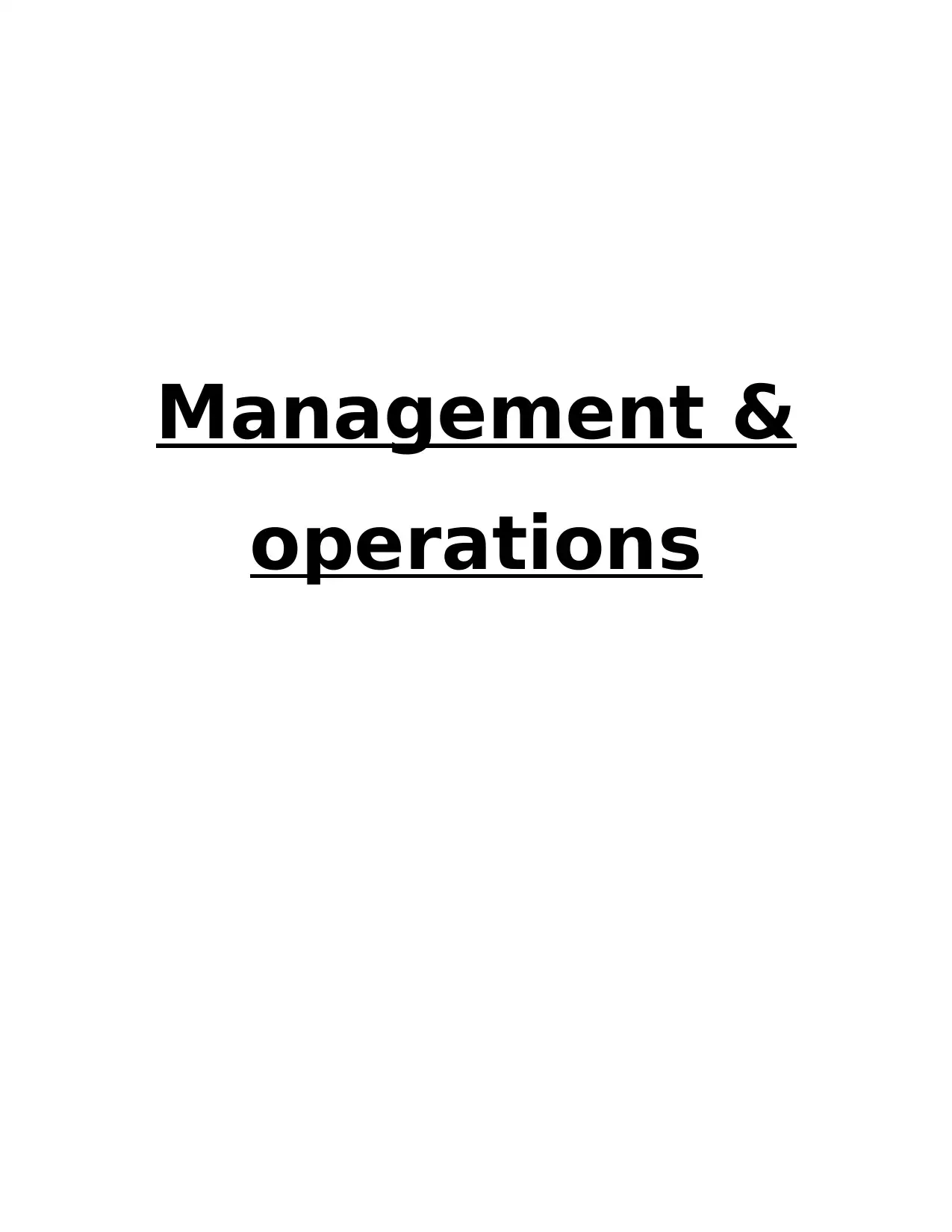
Management &
operations
operations
Paraphrase This Document
Need a fresh take? Get an instant paraphrase of this document with our AI Paraphraser

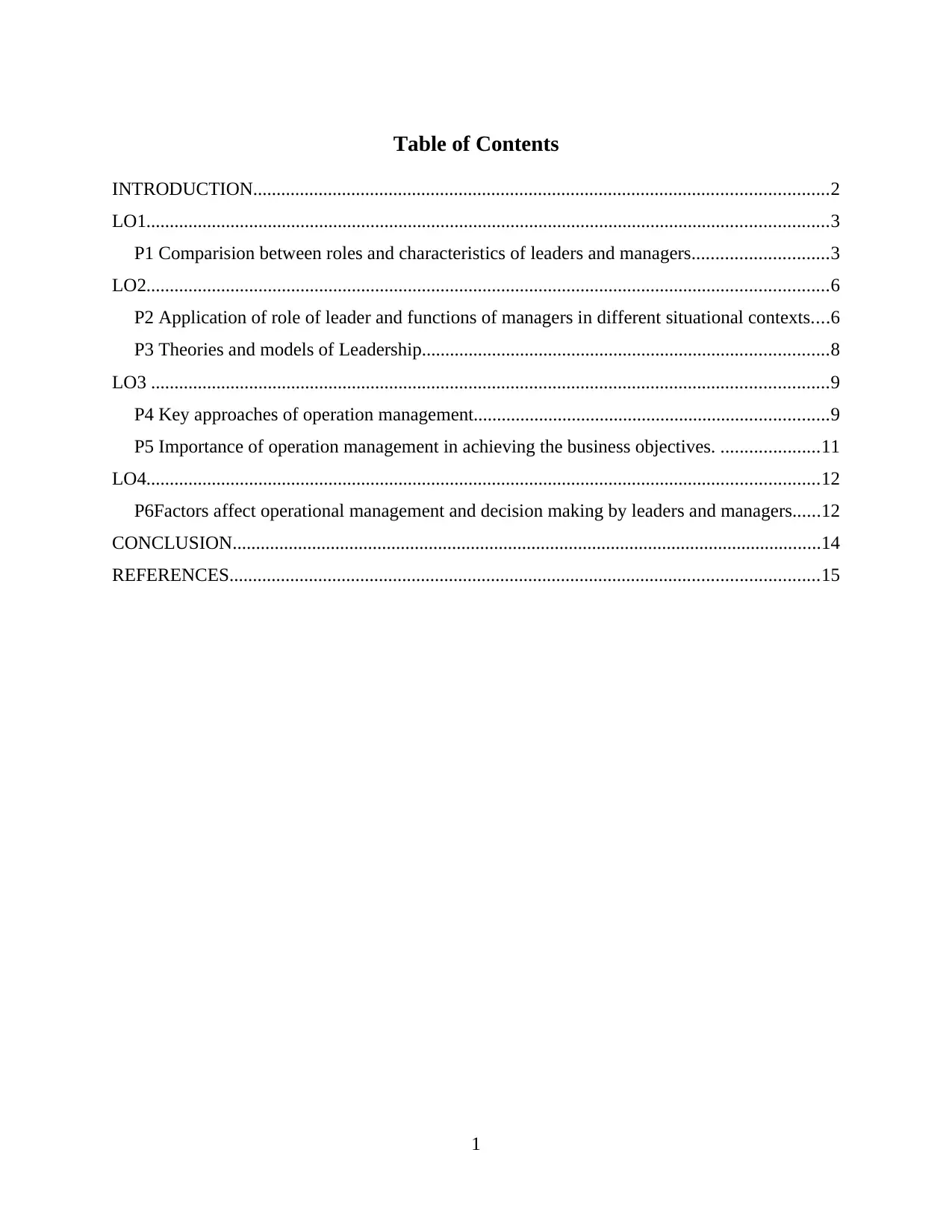
Table of Contents
INTRODUCTION...........................................................................................................................2
LO1..................................................................................................................................................3
P1 Comparision between roles and characteristics of leaders and managers.............................3
LO2..................................................................................................................................................6
P2 Application of role of leader and functions of managers in different situational contexts....6
P3 Theories and models of Leadership.......................................................................................8
LO3 .................................................................................................................................................9
P4 Key approaches of operation management............................................................................9
P5 Importance of operation management in achieving the business objectives. .....................11
LO4................................................................................................................................................12
P6Factors affect operational management and decision making by leaders and managers......12
CONCLUSION..............................................................................................................................14
REFERENCES..............................................................................................................................15
1
INTRODUCTION...........................................................................................................................2
LO1..................................................................................................................................................3
P1 Comparision between roles and characteristics of leaders and managers.............................3
LO2..................................................................................................................................................6
P2 Application of role of leader and functions of managers in different situational contexts....6
P3 Theories and models of Leadership.......................................................................................8
LO3 .................................................................................................................................................9
P4 Key approaches of operation management............................................................................9
P5 Importance of operation management in achieving the business objectives. .....................11
LO4................................................................................................................................................12
P6Factors affect operational management and decision making by leaders and managers......12
CONCLUSION..............................................................................................................................14
REFERENCES..............................................................................................................................15
1
⊘ This is a preview!⊘
Do you want full access?
Subscribe today to unlock all pages.

Trusted by 1+ million students worldwide
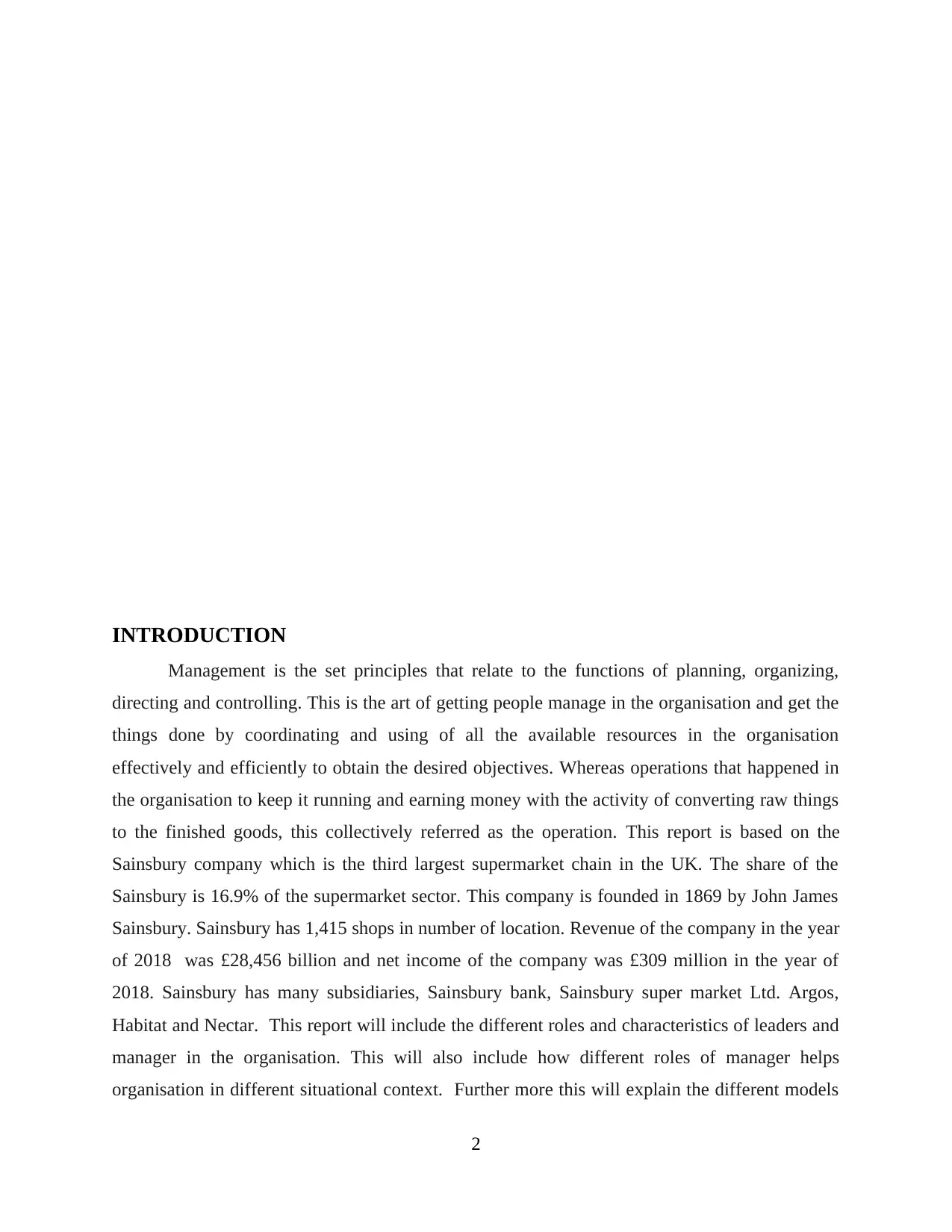
INTRODUCTION
Management is the set principles that relate to the functions of planning, organizing,
directing and controlling. This is the art of getting people manage in the organisation and get the
things done by coordinating and using of all the available resources in the organisation
effectively and efficiently to obtain the desired objectives. Whereas operations that happened in
the organisation to keep it running and earning money with the activity of converting raw things
to the finished goods, this collectively referred as the operation. This report is based on the
Sainsbury company which is the third largest supermarket chain in the UK. The share of the
Sainsbury is 16.9% of the supermarket sector. This company is founded in 1869 by John James
Sainsbury. Sainsbury has 1,415 shops in number of location. Revenue of the company in the year
of 2018 was £28,456 billion and net income of the company was £309 million in the year of
2018. Sainsbury has many subsidiaries, Sainsbury bank, Sainsbury super market Ltd. Argos,
Habitat and Nectar. This report will include the different roles and characteristics of leaders and
manager in the organisation. This will also include how different roles of manager helps
organisation in different situational context. Further more this will explain the different models
2
Management is the set principles that relate to the functions of planning, organizing,
directing and controlling. This is the art of getting people manage in the organisation and get the
things done by coordinating and using of all the available resources in the organisation
effectively and efficiently to obtain the desired objectives. Whereas operations that happened in
the organisation to keep it running and earning money with the activity of converting raw things
to the finished goods, this collectively referred as the operation. This report is based on the
Sainsbury company which is the third largest supermarket chain in the UK. The share of the
Sainsbury is 16.9% of the supermarket sector. This company is founded in 1869 by John James
Sainsbury. Sainsbury has 1,415 shops in number of location. Revenue of the company in the year
of 2018 was £28,456 billion and net income of the company was £309 million in the year of
2018. Sainsbury has many subsidiaries, Sainsbury bank, Sainsbury super market Ltd. Argos,
Habitat and Nectar. This report will include the different roles and characteristics of leaders and
manager in the organisation. This will also include how different roles of manager helps
organisation in different situational context. Further more this will explain the different models
2
Paraphrase This Document
Need a fresh take? Get an instant paraphrase of this document with our AI Paraphraser
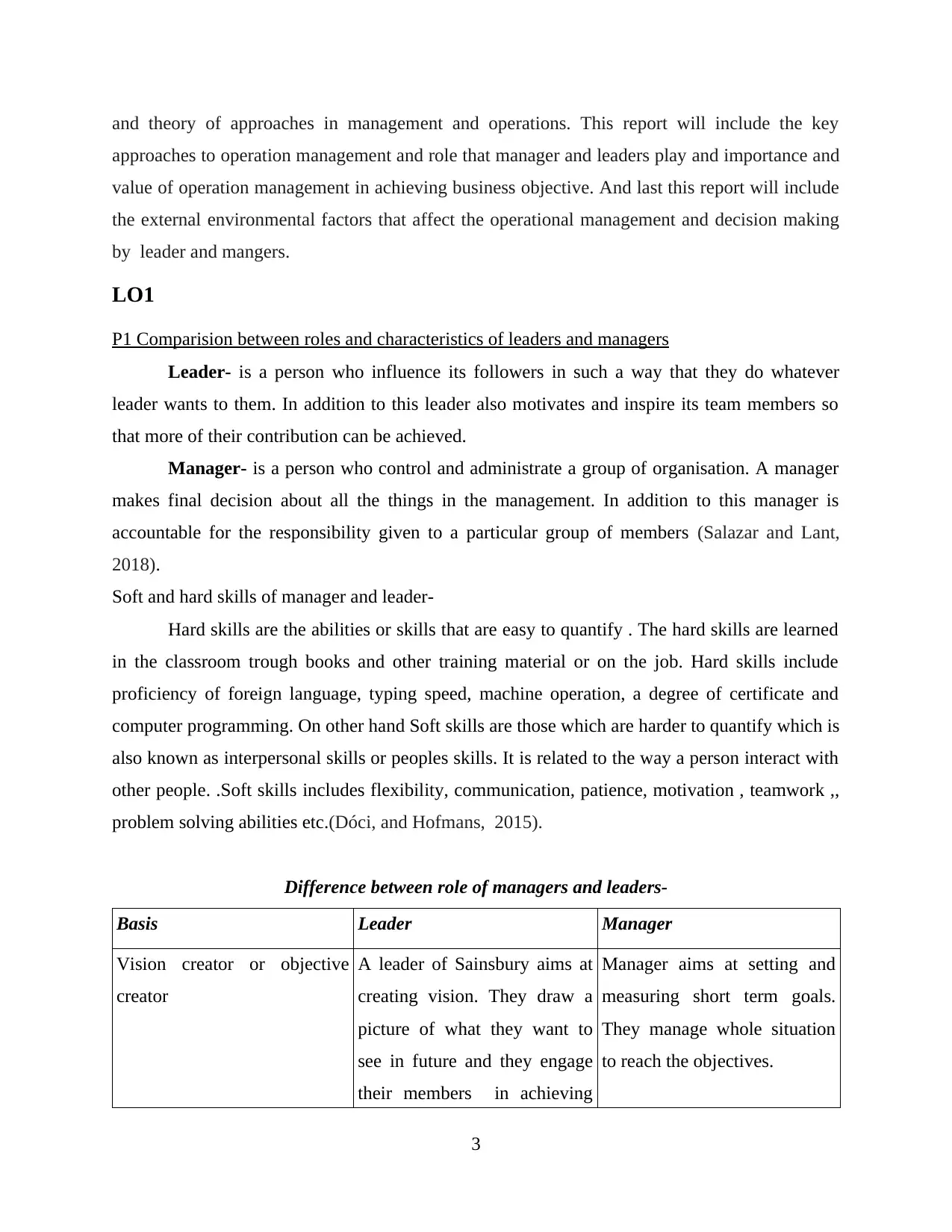
and theory of approaches in management and operations. This report will include the key
approaches to operation management and role that manager and leaders play and importance and
value of operation management in achieving business objective. And last this report will include
the external environmental factors that affect the operational management and decision making
by leader and mangers.
LO1
P1 Comparision between roles and characteristics of leaders and managers
Leader- is a person who influence its followers in such a way that they do whatever
leader wants to them. In addition to this leader also motivates and inspire its team members so
that more of their contribution can be achieved.
Manager- is a person who control and administrate a group of organisation. A manager
makes final decision about all the things in the management. In addition to this manager is
accountable for the responsibility given to a particular group of members (Salazar and Lant,
2018).
Soft and hard skills of manager and leader-
Hard skills are the abilities or skills that are easy to quantify . The hard skills are learned
in the classroom trough books and other training material or on the job. Hard skills include
proficiency of foreign language, typing speed, machine operation, a degree of certificate and
computer programming. On other hand Soft skills are those which are harder to quantify which is
also known as interpersonal skills or peoples skills. It is related to the way a person interact with
other people. .Soft skills includes flexibility, communication, patience, motivation , teamwork ,,
problem solving abilities etc.(Dóci, and Hofmans, 2015).
Difference between role of managers and leaders-
Basis Leader Manager
Vision creator or objective
creator
A leader of Sainsbury aims at
creating vision. They draw a
picture of what they want to
see in future and they engage
their members in achieving
Manager aims at setting and
measuring short term goals.
They manage whole situation
to reach the objectives.
3
approaches to operation management and role that manager and leaders play and importance and
value of operation management in achieving business objective. And last this report will include
the external environmental factors that affect the operational management and decision making
by leader and mangers.
LO1
P1 Comparision between roles and characteristics of leaders and managers
Leader- is a person who influence its followers in such a way that they do whatever
leader wants to them. In addition to this leader also motivates and inspire its team members so
that more of their contribution can be achieved.
Manager- is a person who control and administrate a group of organisation. A manager
makes final decision about all the things in the management. In addition to this manager is
accountable for the responsibility given to a particular group of members (Salazar and Lant,
2018).
Soft and hard skills of manager and leader-
Hard skills are the abilities or skills that are easy to quantify . The hard skills are learned
in the classroom trough books and other training material or on the job. Hard skills include
proficiency of foreign language, typing speed, machine operation, a degree of certificate and
computer programming. On other hand Soft skills are those which are harder to quantify which is
also known as interpersonal skills or peoples skills. It is related to the way a person interact with
other people. .Soft skills includes flexibility, communication, patience, motivation , teamwork ,,
problem solving abilities etc.(Dóci, and Hofmans, 2015).
Difference between role of managers and leaders-
Basis Leader Manager
Vision creator or objective
creator
A leader of Sainsbury aims at
creating vision. They draw a
picture of what they want to
see in future and they engage
their members in achieving
Manager aims at setting and
measuring short term goals.
They manage whole situation
to reach the objectives.
3
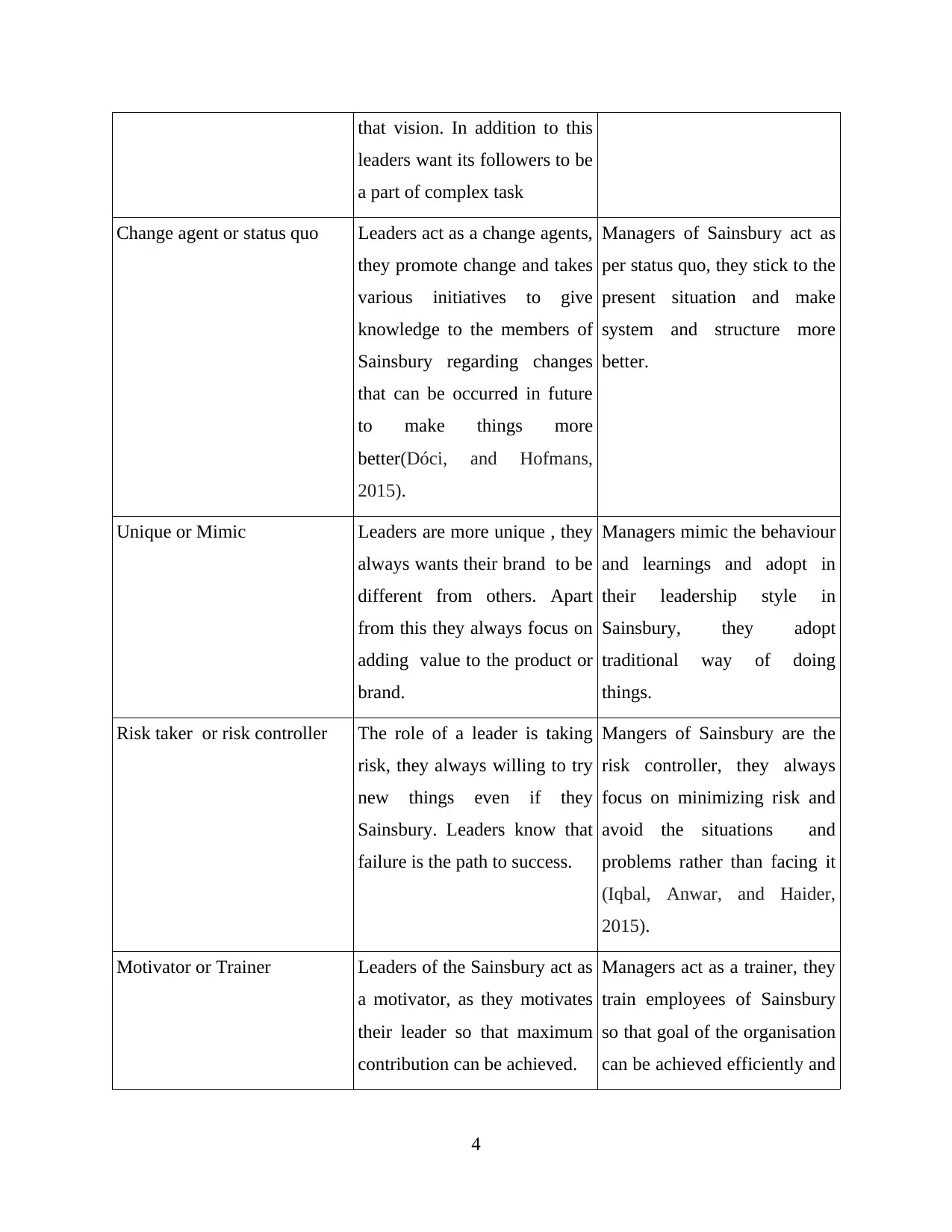
that vision. In addition to this
leaders want its followers to be
a part of complex task
Change agent or status quo Leaders act as a change agents,
they promote change and takes
various initiatives to give
knowledge to the members of
Sainsbury regarding changes
that can be occurred in future
to make things more
better(Dóci, and Hofmans,
2015).
Managers of Sainsbury act as
per status quo, they stick to the
present situation and make
system and structure more
better.
Unique or Mimic Leaders are more unique , they
always wants their brand to be
different from others. Apart
from this they always focus on
adding value to the product or
brand.
Managers mimic the behaviour
and learnings and adopt in
their leadership style in
Sainsbury, they adopt
traditional way of doing
things.
Risk taker or risk controller The role of a leader is taking
risk, they always willing to try
new things even if they
Sainsbury. Leaders know that
failure is the path to success.
Mangers of Sainsbury are the
risk controller, they always
focus on minimizing risk and
avoid the situations and
problems rather than facing it
(Iqbal, Anwar, and Haider,
2015).
Motivator or Trainer Leaders of the Sainsbury act as
a motivator, as they motivates
their leader so that maximum
contribution can be achieved.
Managers act as a trainer, they
train employees of Sainsbury
so that goal of the organisation
can be achieved efficiently and
4
leaders want its followers to be
a part of complex task
Change agent or status quo Leaders act as a change agents,
they promote change and takes
various initiatives to give
knowledge to the members of
Sainsbury regarding changes
that can be occurred in future
to make things more
better(Dóci, and Hofmans,
2015).
Managers of Sainsbury act as
per status quo, they stick to the
present situation and make
system and structure more
better.
Unique or Mimic Leaders are more unique , they
always wants their brand to be
different from others. Apart
from this they always focus on
adding value to the product or
brand.
Managers mimic the behaviour
and learnings and adopt in
their leadership style in
Sainsbury, they adopt
traditional way of doing
things.
Risk taker or risk controller The role of a leader is taking
risk, they always willing to try
new things even if they
Sainsbury. Leaders know that
failure is the path to success.
Mangers of Sainsbury are the
risk controller, they always
focus on minimizing risk and
avoid the situations and
problems rather than facing it
(Iqbal, Anwar, and Haider,
2015).
Motivator or Trainer Leaders of the Sainsbury act as
a motivator, as they motivates
their leader so that maximum
contribution can be achieved.
Managers act as a trainer, they
train employees of Sainsbury
so that goal of the organisation
can be achieved efficiently and
4
⊘ This is a preview!⊘
Do you want full access?
Subscribe today to unlock all pages.

Trusted by 1+ million students worldwide
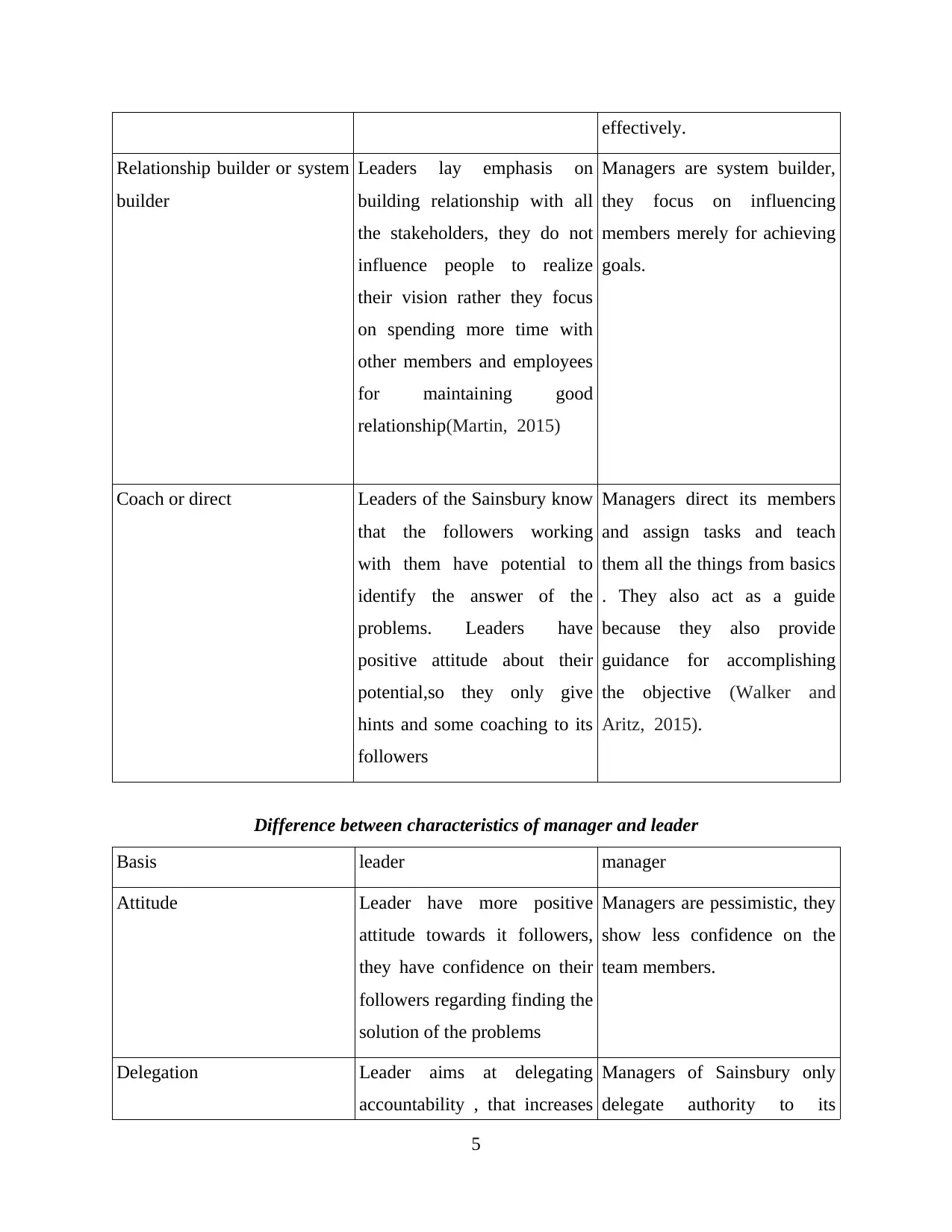
effectively.
Relationship builder or system
builder
Leaders lay emphasis on
building relationship with all
the stakeholders, they do not
influence people to realize
their vision rather they focus
on spending more time with
other members and employees
for maintaining good
relationship(Martin, 2015)
Managers are system builder,
they focus on influencing
members merely for achieving
goals.
Coach or direct Leaders of the Sainsbury know
that the followers working
with them have potential to
identify the answer of the
problems. Leaders have
positive attitude about their
potential,so they only give
hints and some coaching to its
followers
Managers direct its members
and assign tasks and teach
them all the things from basics
. They also act as a guide
because they also provide
guidance for accomplishing
the objective (Walker and
Aritz, 2015).
Difference between characteristics of manager and leader
Basis leader manager
Attitude Leader have more positive
attitude towards it followers,
they have confidence on their
followers regarding finding the
solution of the problems
Managers are pessimistic, they
show less confidence on the
team members.
Delegation Leader aims at delegating
accountability , that increases
Managers of Sainsbury only
delegate authority to its
5
Relationship builder or system
builder
Leaders lay emphasis on
building relationship with all
the stakeholders, they do not
influence people to realize
their vision rather they focus
on spending more time with
other members and employees
for maintaining good
relationship(Martin, 2015)
Managers are system builder,
they focus on influencing
members merely for achieving
goals.
Coach or direct Leaders of the Sainsbury know
that the followers working
with them have potential to
identify the answer of the
problems. Leaders have
positive attitude about their
potential,so they only give
hints and some coaching to its
followers
Managers direct its members
and assign tasks and teach
them all the things from basics
. They also act as a guide
because they also provide
guidance for accomplishing
the objective (Walker and
Aritz, 2015).
Difference between characteristics of manager and leader
Basis leader manager
Attitude Leader have more positive
attitude towards it followers,
they have confidence on their
followers regarding finding the
solution of the problems
Managers are pessimistic, they
show less confidence on the
team members.
Delegation Leader aims at delegating
accountability , that increases
Managers of Sainsbury only
delegate authority to its
5
Paraphrase This Document
Need a fresh take? Get an instant paraphrase of this document with our AI Paraphraser
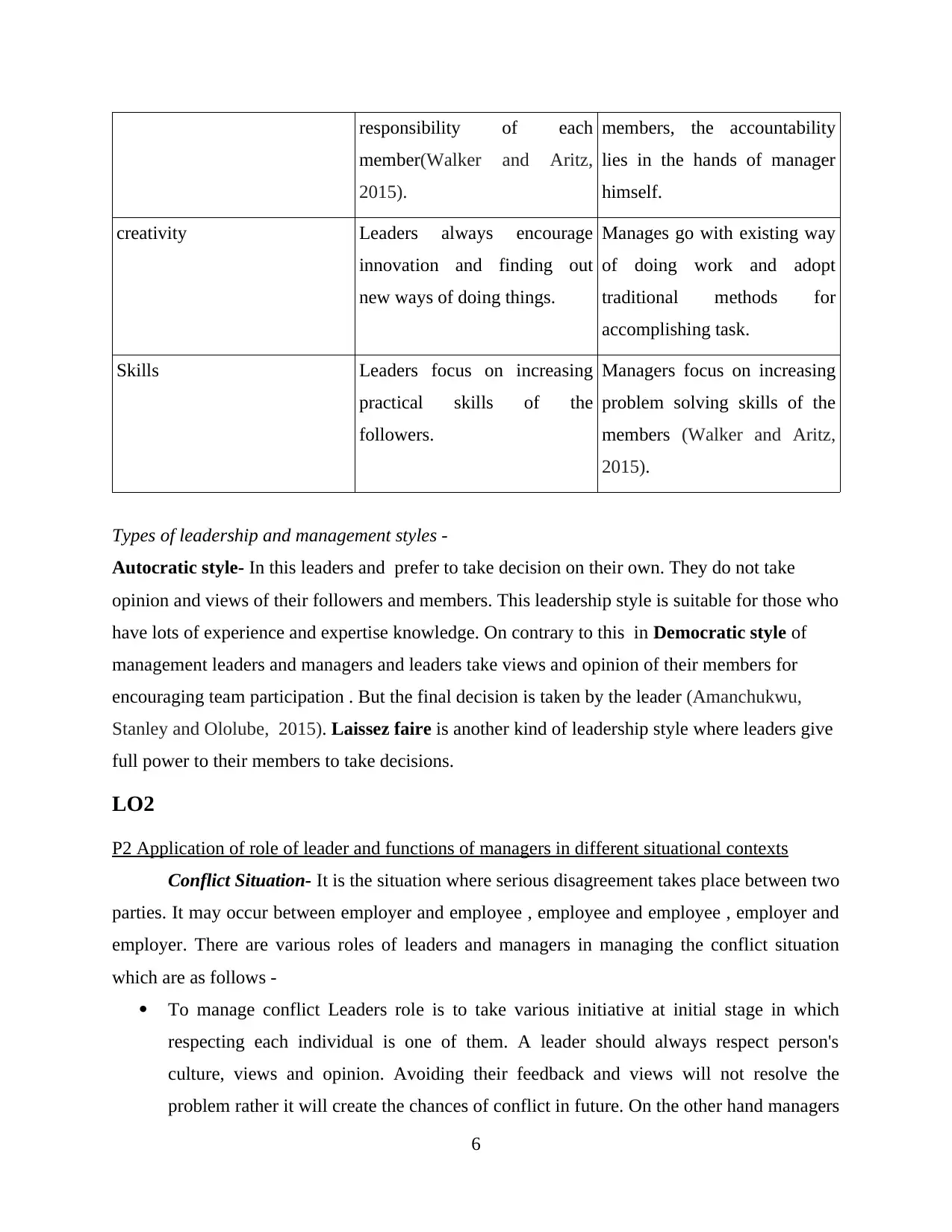
responsibility of each
member(Walker and Aritz,
2015).
members, the accountability
lies in the hands of manager
himself.
creativity Leaders always encourage
innovation and finding out
new ways of doing things.
Manages go with existing way
of doing work and adopt
traditional methods for
accomplishing task.
Skills Leaders focus on increasing
practical skills of the
followers.
Managers focus on increasing
problem solving skills of the
members (Walker and Aritz,
2015).
Types of leadership and management styles -
Autocratic style- In this leaders and prefer to take decision on their own. They do not take
opinion and views of their followers and members. This leadership style is suitable for those who
have lots of experience and expertise knowledge. On contrary to this in Democratic style of
management leaders and managers and leaders take views and opinion of their members for
encouraging team participation . But the final decision is taken by the leader (Amanchukwu,
Stanley and Ololube, 2015). Laissez faire is another kind of leadership style where leaders give
full power to their members to take decisions.
LO2
P2 Application of role of leader and functions of managers in different situational contexts
Conflict Situation- It is the situation where serious disagreement takes place between two
parties. It may occur between employer and employee , employee and employee , employer and
employer. There are various roles of leaders and managers in managing the conflict situation
which are as follows -
To manage conflict Leaders role is to take various initiative at initial stage in which
respecting each individual is one of them. A leader should always respect person's
culture, views and opinion. Avoiding their feedback and views will not resolve the
problem rather it will create the chances of conflict in future. On the other hand managers
6
member(Walker and Aritz,
2015).
members, the accountability
lies in the hands of manager
himself.
creativity Leaders always encourage
innovation and finding out
new ways of doing things.
Manages go with existing way
of doing work and adopt
traditional methods for
accomplishing task.
Skills Leaders focus on increasing
practical skills of the
followers.
Managers focus on increasing
problem solving skills of the
members (Walker and Aritz,
2015).
Types of leadership and management styles -
Autocratic style- In this leaders and prefer to take decision on their own. They do not take
opinion and views of their followers and members. This leadership style is suitable for those who
have lots of experience and expertise knowledge. On contrary to this in Democratic style of
management leaders and managers and leaders take views and opinion of their members for
encouraging team participation . But the final decision is taken by the leader (Amanchukwu,
Stanley and Ololube, 2015). Laissez faire is another kind of leadership style where leaders give
full power to their members to take decisions.
LO2
P2 Application of role of leader and functions of managers in different situational contexts
Conflict Situation- It is the situation where serious disagreement takes place between two
parties. It may occur between employer and employee , employee and employee , employer and
employer. There are various roles of leaders and managers in managing the conflict situation
which are as follows -
To manage conflict Leaders role is to take various initiative at initial stage in which
respecting each individual is one of them. A leader should always respect person's
culture, views and opinion. Avoiding their feedback and views will not resolve the
problem rather it will create the chances of conflict in future. On the other hand managers
6
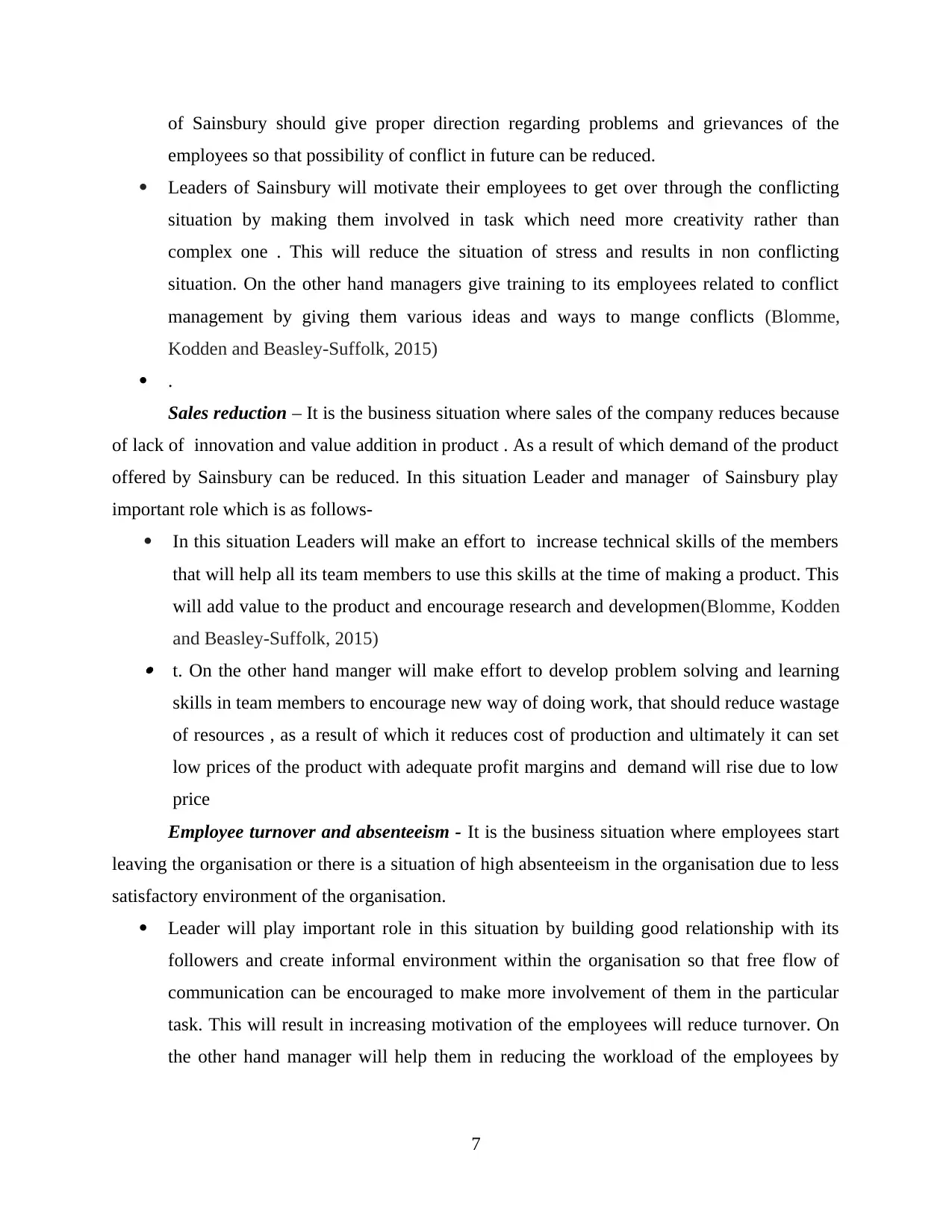
of Sainsbury should give proper direction regarding problems and grievances of the
employees so that possibility of conflict in future can be reduced.
Leaders of Sainsbury will motivate their employees to get over through the conflicting
situation by making them involved in task which need more creativity rather than
complex one . This will reduce the situation of stress and results in non conflicting
situation. On the other hand managers give training to its employees related to conflict
management by giving them various ideas and ways to mange conflicts (Blomme,
Kodden and Beasley-Suffolk, 2015)
.
Sales reduction – It is the business situation where sales of the company reduces because
of lack of innovation and value addition in product . As a result of which demand of the product
offered by Sainsbury can be reduced. In this situation Leader and manager of Sainsbury play
important role which is as follows-
In this situation Leaders will make an effort to increase technical skills of the members
that will help all its team members to use this skills at the time of making a product. This
will add value to the product and encourage research and developmen(Blomme, Kodden
and Beasley-Suffolk, 2015) t. On the other hand manger will make effort to develop problem solving and learning
skills in team members to encourage new way of doing work, that should reduce wastage
of resources , as a result of which it reduces cost of production and ultimately it can set
low prices of the product with adequate profit margins and demand will rise due to low
price
Employee turnover and absenteeism - It is the business situation where employees start
leaving the organisation or there is a situation of high absenteeism in the organisation due to less
satisfactory environment of the organisation.
Leader will play important role in this situation by building good relationship with its
followers and create informal environment within the organisation so that free flow of
communication can be encouraged to make more involvement of them in the particular
task. This will result in increasing motivation of the employees will reduce turnover. On
the other hand manager will help them in reducing the workload of the employees by
7
employees so that possibility of conflict in future can be reduced.
Leaders of Sainsbury will motivate their employees to get over through the conflicting
situation by making them involved in task which need more creativity rather than
complex one . This will reduce the situation of stress and results in non conflicting
situation. On the other hand managers give training to its employees related to conflict
management by giving them various ideas and ways to mange conflicts (Blomme,
Kodden and Beasley-Suffolk, 2015)
.
Sales reduction – It is the business situation where sales of the company reduces because
of lack of innovation and value addition in product . As a result of which demand of the product
offered by Sainsbury can be reduced. In this situation Leader and manager of Sainsbury play
important role which is as follows-
In this situation Leaders will make an effort to increase technical skills of the members
that will help all its team members to use this skills at the time of making a product. This
will add value to the product and encourage research and developmen(Blomme, Kodden
and Beasley-Suffolk, 2015) t. On the other hand manger will make effort to develop problem solving and learning
skills in team members to encourage new way of doing work, that should reduce wastage
of resources , as a result of which it reduces cost of production and ultimately it can set
low prices of the product with adequate profit margins and demand will rise due to low
price
Employee turnover and absenteeism - It is the business situation where employees start
leaving the organisation or there is a situation of high absenteeism in the organisation due to less
satisfactory environment of the organisation.
Leader will play important role in this situation by building good relationship with its
followers and create informal environment within the organisation so that free flow of
communication can be encouraged to make more involvement of them in the particular
task. This will result in increasing motivation of the employees will reduce turnover. On
the other hand manager will help them in reducing the workload of the employees by
7
⊘ This is a preview!⊘
Do you want full access?
Subscribe today to unlock all pages.

Trusted by 1+ million students worldwide
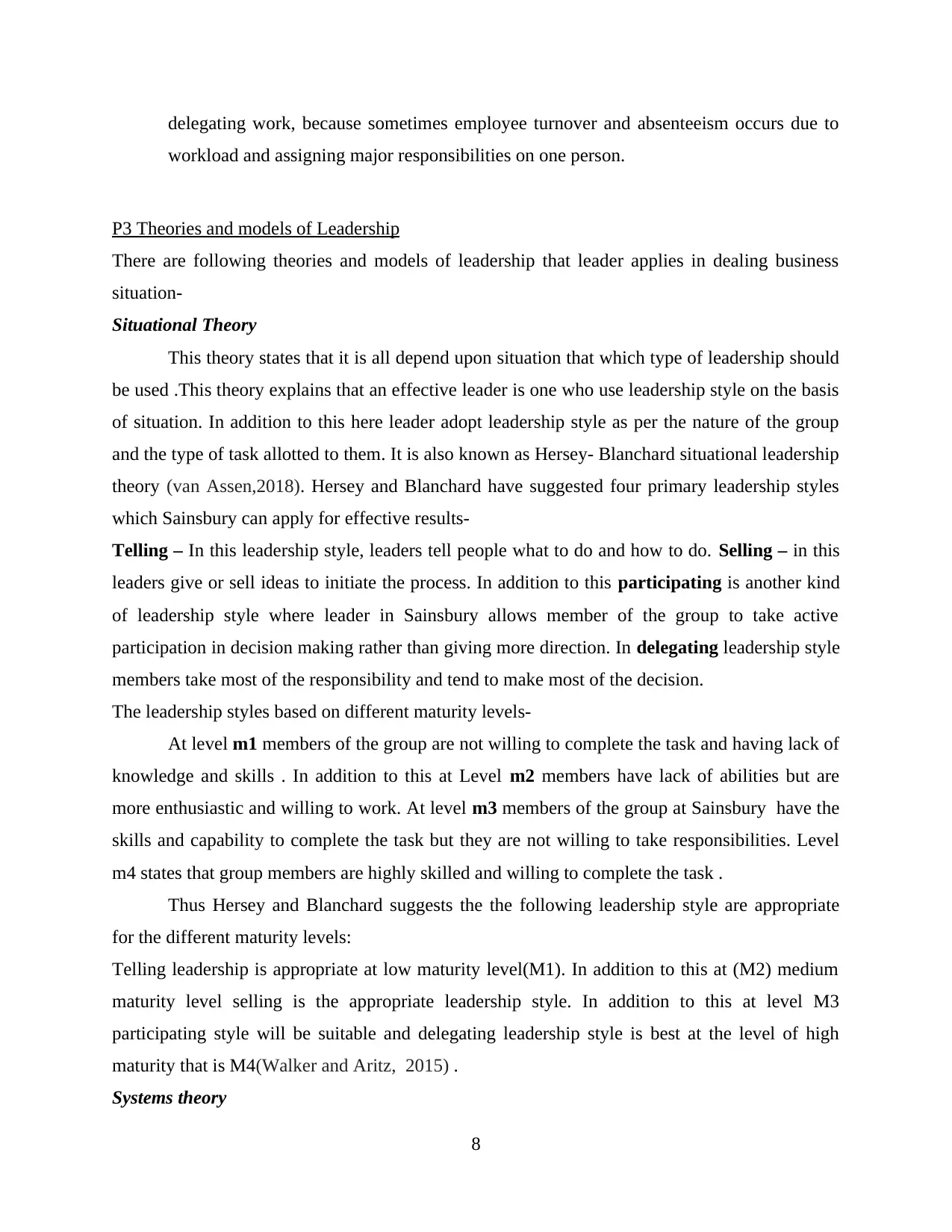
delegating work, because sometimes employee turnover and absenteeism occurs due to
workload and assigning major responsibilities on one person.
P3 Theories and models of Leadership
There are following theories and models of leadership that leader applies in dealing business
situation-
Situational Theory
This theory states that it is all depend upon situation that which type of leadership should
be used .This theory explains that an effective leader is one who use leadership style on the basis
of situation. In addition to this here leader adopt leadership style as per the nature of the group
and the type of task allotted to them. It is also known as Hersey- Blanchard situational leadership
theory (van Assen,2018). Hersey and Blanchard have suggested four primary leadership styles
which Sainsbury can apply for effective results-
Telling – In this leadership style, leaders tell people what to do and how to do. Selling – in this
leaders give or sell ideas to initiate the process. In addition to this participating is another kind
of leadership style where leader in Sainsbury allows member of the group to take active
participation in decision making rather than giving more direction. In delegating leadership style
members take most of the responsibility and tend to make most of the decision.
The leadership styles based on different maturity levels-
At level m1 members of the group are not willing to complete the task and having lack of
knowledge and skills . In addition to this at Level m2 members have lack of abilities but are
more enthusiastic and willing to work. At level m3 members of the group at Sainsbury have the
skills and capability to complete the task but they are not willing to take responsibilities. Level
m4 states that group members are highly skilled and willing to complete the task .
Thus Hersey and Blanchard suggests the the following leadership style are appropriate
for the different maturity levels:
Telling leadership is appropriate at low maturity level(M1). In addition to this at (M2) medium
maturity level selling is the appropriate leadership style. In addition to this at level M3
participating style will be suitable and delegating leadership style is best at the level of high
maturity that is M4(Walker and Aritz, 2015) .
Systems theory
8
workload and assigning major responsibilities on one person.
P3 Theories and models of Leadership
There are following theories and models of leadership that leader applies in dealing business
situation-
Situational Theory
This theory states that it is all depend upon situation that which type of leadership should
be used .This theory explains that an effective leader is one who use leadership style on the basis
of situation. In addition to this here leader adopt leadership style as per the nature of the group
and the type of task allotted to them. It is also known as Hersey- Blanchard situational leadership
theory (van Assen,2018). Hersey and Blanchard have suggested four primary leadership styles
which Sainsbury can apply for effective results-
Telling – In this leadership style, leaders tell people what to do and how to do. Selling – in this
leaders give or sell ideas to initiate the process. In addition to this participating is another kind
of leadership style where leader in Sainsbury allows member of the group to take active
participation in decision making rather than giving more direction. In delegating leadership style
members take most of the responsibility and tend to make most of the decision.
The leadership styles based on different maturity levels-
At level m1 members of the group are not willing to complete the task and having lack of
knowledge and skills . In addition to this at Level m2 members have lack of abilities but are
more enthusiastic and willing to work. At level m3 members of the group at Sainsbury have the
skills and capability to complete the task but they are not willing to take responsibilities. Level
m4 states that group members are highly skilled and willing to complete the task .
Thus Hersey and Blanchard suggests the the following leadership style are appropriate
for the different maturity levels:
Telling leadership is appropriate at low maturity level(M1). In addition to this at (M2) medium
maturity level selling is the appropriate leadership style. In addition to this at level M3
participating style will be suitable and delegating leadership style is best at the level of high
maturity that is M4(Walker and Aritz, 2015) .
Systems theory
8
Paraphrase This Document
Need a fresh take? Get an instant paraphrase of this document with our AI Paraphraser
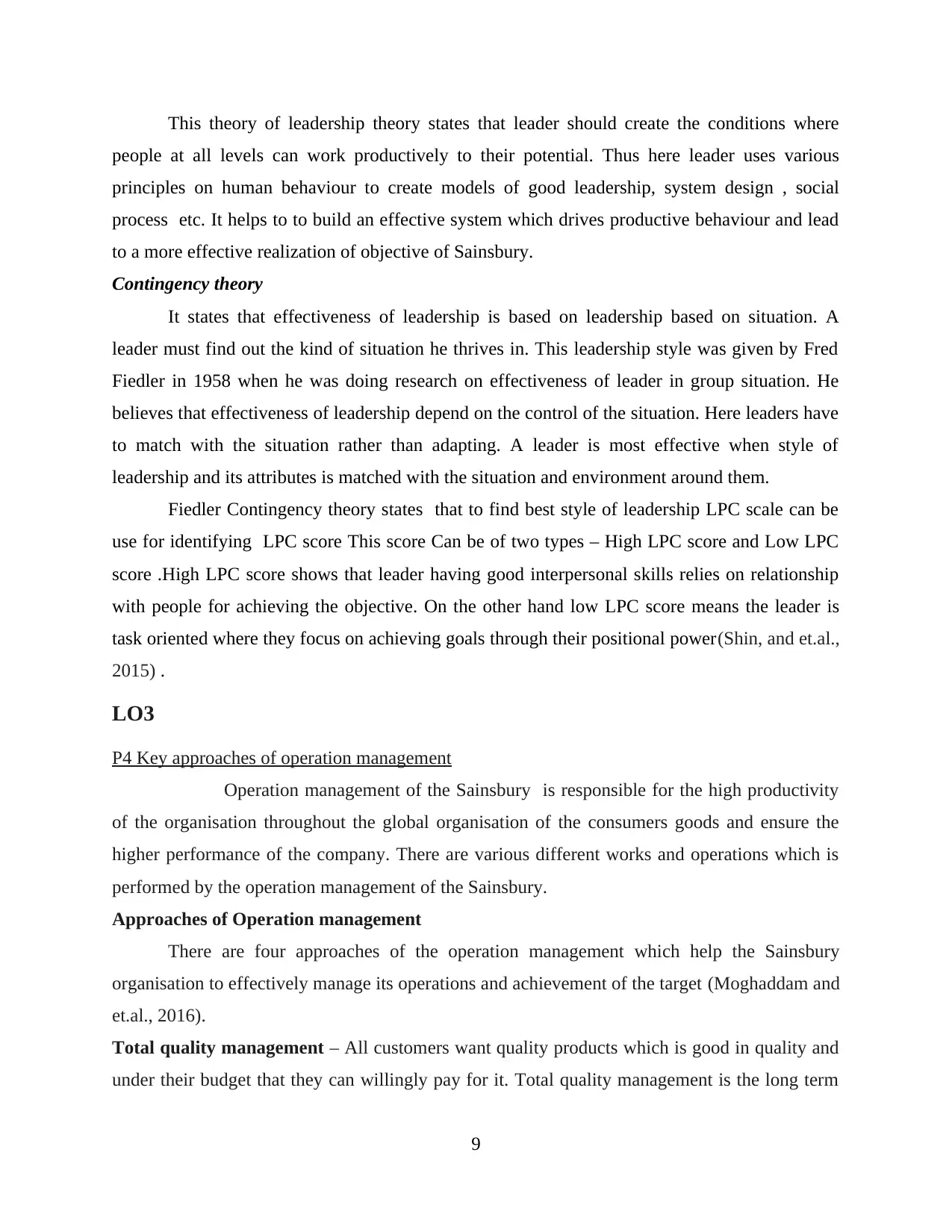
This theory of leadership theory states that leader should create the conditions where
people at all levels can work productively to their potential. Thus here leader uses various
principles on human behaviour to create models of good leadership, system design , social
process etc. It helps to to build an effective system which drives productive behaviour and lead
to a more effective realization of objective of Sainsbury.
Contingency theory
It states that effectiveness of leadership is based on leadership based on situation. A
leader must find out the kind of situation he thrives in. This leadership style was given by Fred
Fiedler in 1958 when he was doing research on effectiveness of leader in group situation. He
believes that effectiveness of leadership depend on the control of the situation. Here leaders have
to match with the situation rather than adapting. A leader is most effective when style of
leadership and its attributes is matched with the situation and environment around them.
Fiedler Contingency theory states that to find best style of leadership LPC scale can be
use for identifying LPC score This score Can be of two types – High LPC score and Low LPC
score .High LPC score shows that leader having good interpersonal skills relies on relationship
with people for achieving the objective. On the other hand low LPC score means the leader is
task oriented where they focus on achieving goals through their positional power(Shin, and et.al.,
2015) .
LO3
P4 Key approaches of operation management
Operation management of the Sainsbury is responsible for the high productivity
of the organisation throughout the global organisation of the consumers goods and ensure the
higher performance of the company. There are various different works and operations which is
performed by the operation management of the Sainsbury.
Approaches of Operation management
There are four approaches of the operation management which help the Sainsbury
organisation to effectively manage its operations and achievement of the target (Moghaddam and
et.al., 2016).
Total quality management – All customers want quality products which is good in quality and
under their budget that they can willingly pay for it. Total quality management is the long term
9
people at all levels can work productively to their potential. Thus here leader uses various
principles on human behaviour to create models of good leadership, system design , social
process etc. It helps to to build an effective system which drives productive behaviour and lead
to a more effective realization of objective of Sainsbury.
Contingency theory
It states that effectiveness of leadership is based on leadership based on situation. A
leader must find out the kind of situation he thrives in. This leadership style was given by Fred
Fiedler in 1958 when he was doing research on effectiveness of leader in group situation. He
believes that effectiveness of leadership depend on the control of the situation. Here leaders have
to match with the situation rather than adapting. A leader is most effective when style of
leadership and its attributes is matched with the situation and environment around them.
Fiedler Contingency theory states that to find best style of leadership LPC scale can be
use for identifying LPC score This score Can be of two types – High LPC score and Low LPC
score .High LPC score shows that leader having good interpersonal skills relies on relationship
with people for achieving the objective. On the other hand low LPC score means the leader is
task oriented where they focus on achieving goals through their positional power(Shin, and et.al.,
2015) .
LO3
P4 Key approaches of operation management
Operation management of the Sainsbury is responsible for the high productivity
of the organisation throughout the global organisation of the consumers goods and ensure the
higher performance of the company. There are various different works and operations which is
performed by the operation management of the Sainsbury.
Approaches of Operation management
There are four approaches of the operation management which help the Sainsbury
organisation to effectively manage its operations and achievement of the target (Moghaddam and
et.al., 2016).
Total quality management – All customers want quality products which is good in quality and
under their budget that they can willingly pay for it. Total quality management is the long term
9
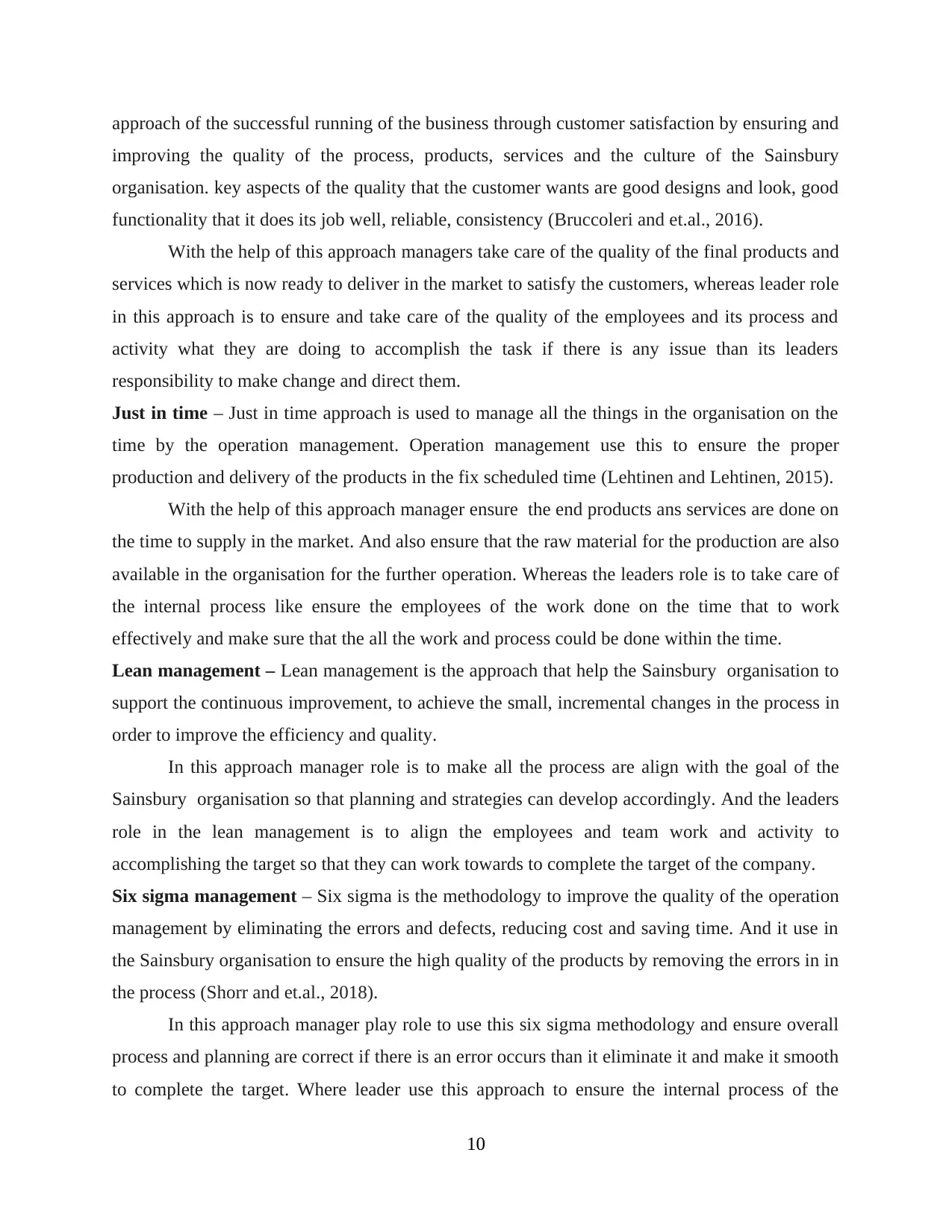
approach of the successful running of the business through customer satisfaction by ensuring and
improving the quality of the process, products, services and the culture of the Sainsbury
organisation. key aspects of the quality that the customer wants are good designs and look, good
functionality that it does its job well, reliable, consistency (Bruccoleri and et.al., 2016).
With the help of this approach managers take care of the quality of the final products and
services which is now ready to deliver in the market to satisfy the customers, whereas leader role
in this approach is to ensure and take care of the quality of the employees and its process and
activity what they are doing to accomplish the task if there is any issue than its leaders
responsibility to make change and direct them.
Just in time – Just in time approach is used to manage all the things in the organisation on the
time by the operation management. Operation management use this to ensure the proper
production and delivery of the products in the fix scheduled time (Lehtinen and Lehtinen, 2015).
With the help of this approach manager ensure the end products ans services are done on
the time to supply in the market. And also ensure that the raw material for the production are also
available in the organisation for the further operation. Whereas the leaders role is to take care of
the internal process like ensure the employees of the work done on the time that to work
effectively and make sure that the all the work and process could be done within the time.
Lean management – Lean management is the approach that help the Sainsbury organisation to
support the continuous improvement, to achieve the small, incremental changes in the process in
order to improve the efficiency and quality.
In this approach manager role is to make all the process are align with the goal of the
Sainsbury organisation so that planning and strategies can develop accordingly. And the leaders
role in the lean management is to align the employees and team work and activity to
accomplishing the target so that they can work towards to complete the target of the company.
Six sigma management – Six sigma is the methodology to improve the quality of the operation
management by eliminating the errors and defects, reducing cost and saving time. And it use in
the Sainsbury organisation to ensure the high quality of the products by removing the errors in in
the process (Shorr and et.al., 2018).
In this approach manager play role to use this six sigma methodology and ensure overall
process and planning are correct if there is an error occurs than it eliminate it and make it smooth
to complete the target. Where leader use this approach to ensure the internal process of the
10
improving the quality of the process, products, services and the culture of the Sainsbury
organisation. key aspects of the quality that the customer wants are good designs and look, good
functionality that it does its job well, reliable, consistency (Bruccoleri and et.al., 2016).
With the help of this approach managers take care of the quality of the final products and
services which is now ready to deliver in the market to satisfy the customers, whereas leader role
in this approach is to ensure and take care of the quality of the employees and its process and
activity what they are doing to accomplish the task if there is any issue than its leaders
responsibility to make change and direct them.
Just in time – Just in time approach is used to manage all the things in the organisation on the
time by the operation management. Operation management use this to ensure the proper
production and delivery of the products in the fix scheduled time (Lehtinen and Lehtinen, 2015).
With the help of this approach manager ensure the end products ans services are done on
the time to supply in the market. And also ensure that the raw material for the production are also
available in the organisation for the further operation. Whereas the leaders role is to take care of
the internal process like ensure the employees of the work done on the time that to work
effectively and make sure that the all the work and process could be done within the time.
Lean management – Lean management is the approach that help the Sainsbury organisation to
support the continuous improvement, to achieve the small, incremental changes in the process in
order to improve the efficiency and quality.
In this approach manager role is to make all the process are align with the goal of the
Sainsbury organisation so that planning and strategies can develop accordingly. And the leaders
role in the lean management is to align the employees and team work and activity to
accomplishing the target so that they can work towards to complete the target of the company.
Six sigma management – Six sigma is the methodology to improve the quality of the operation
management by eliminating the errors and defects, reducing cost and saving time. And it use in
the Sainsbury organisation to ensure the high quality of the products by removing the errors in in
the process (Shorr and et.al., 2018).
In this approach manager play role to use this six sigma methodology and ensure overall
process and planning are correct if there is an error occurs than it eliminate it and make it smooth
to complete the target. Where leader use this approach to ensure the internal process of the
10
⊘ This is a preview!⊘
Do you want full access?
Subscribe today to unlock all pages.

Trusted by 1+ million students worldwide
1 out of 18
Related Documents
Your All-in-One AI-Powered Toolkit for Academic Success.
+13062052269
info@desklib.com
Available 24*7 on WhatsApp / Email
![[object Object]](/_next/static/media/star-bottom.7253800d.svg)
Unlock your academic potential
Copyright © 2020–2025 A2Z Services. All Rights Reserved. Developed and managed by ZUCOL.





